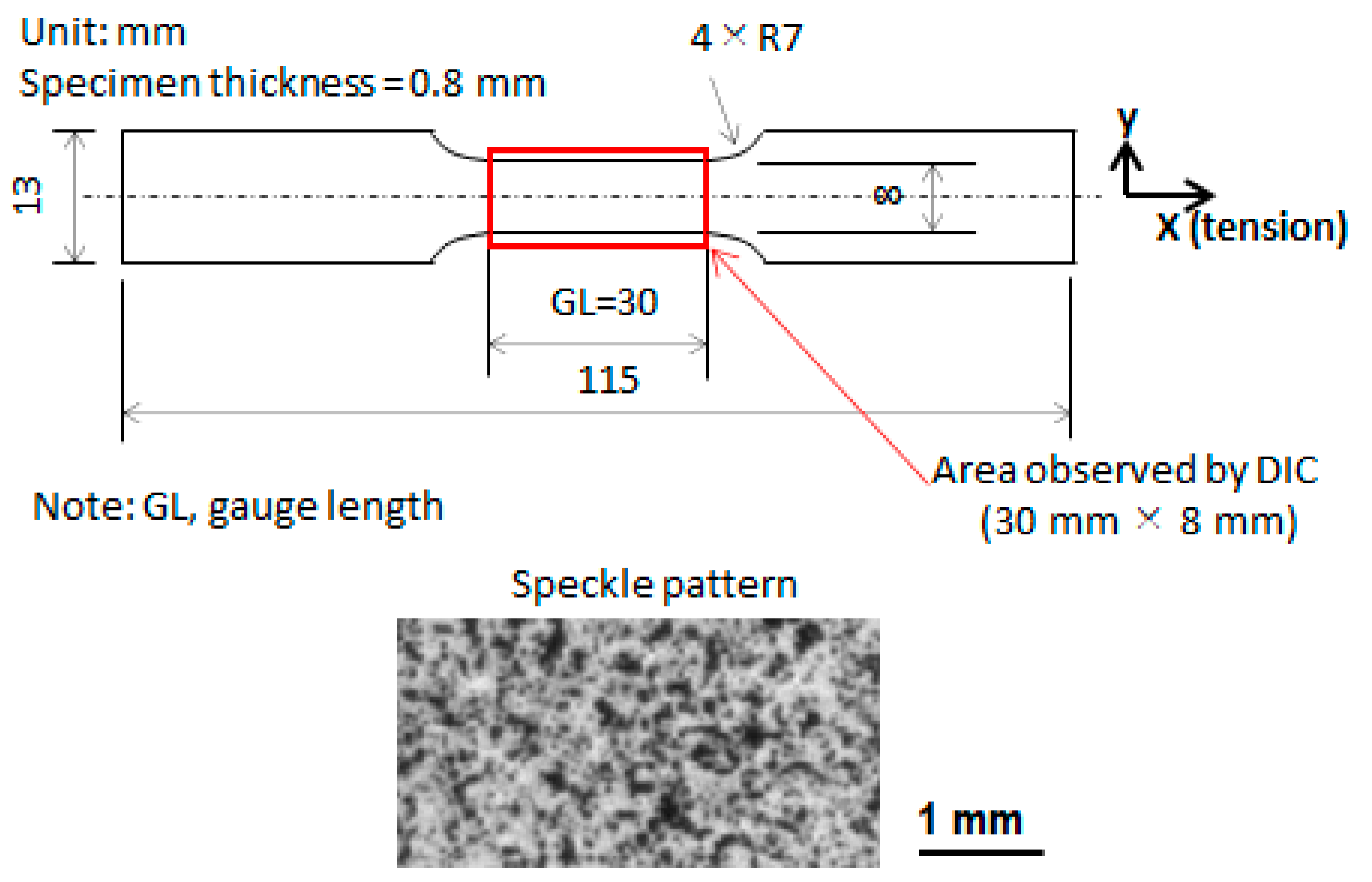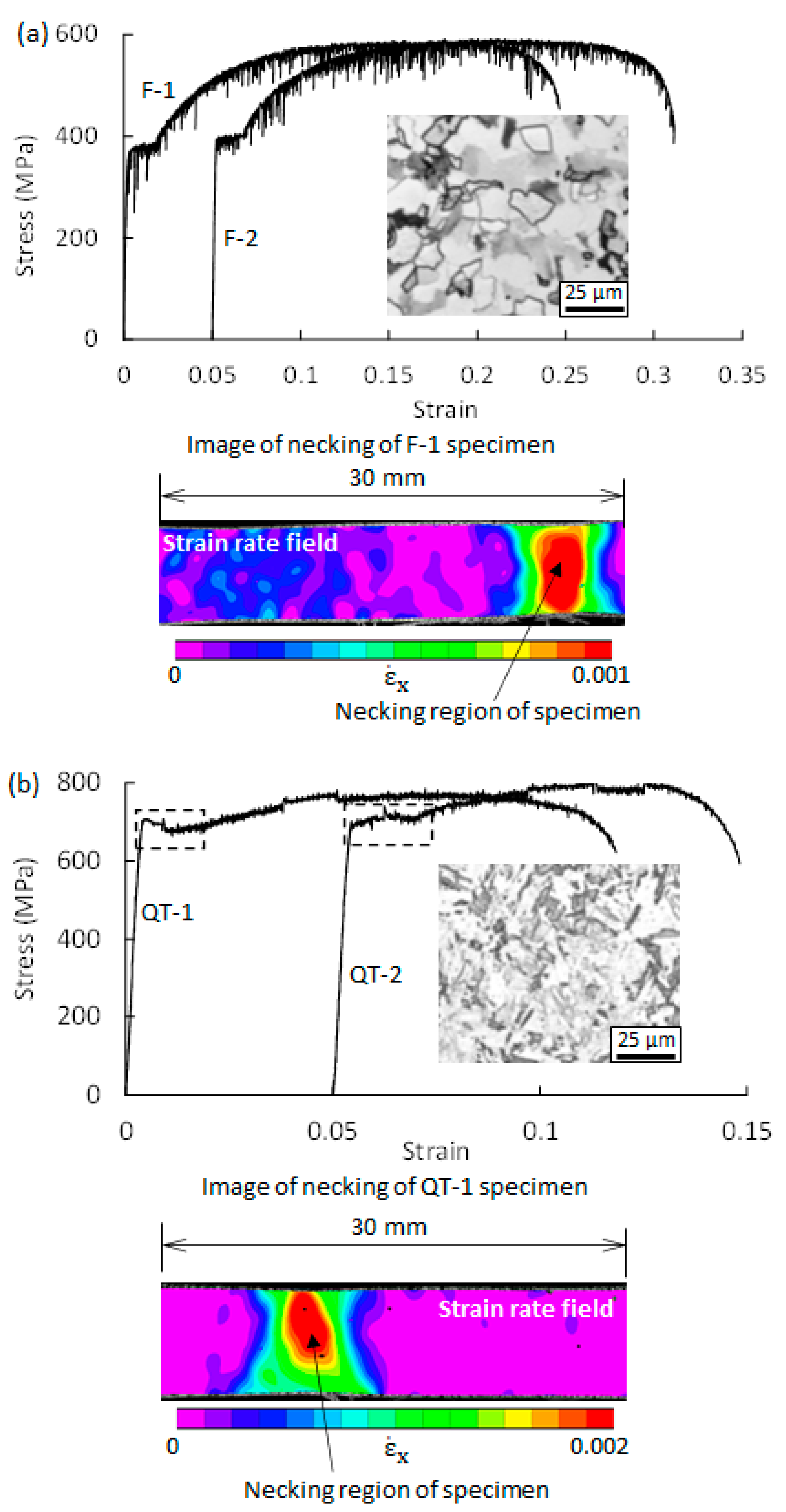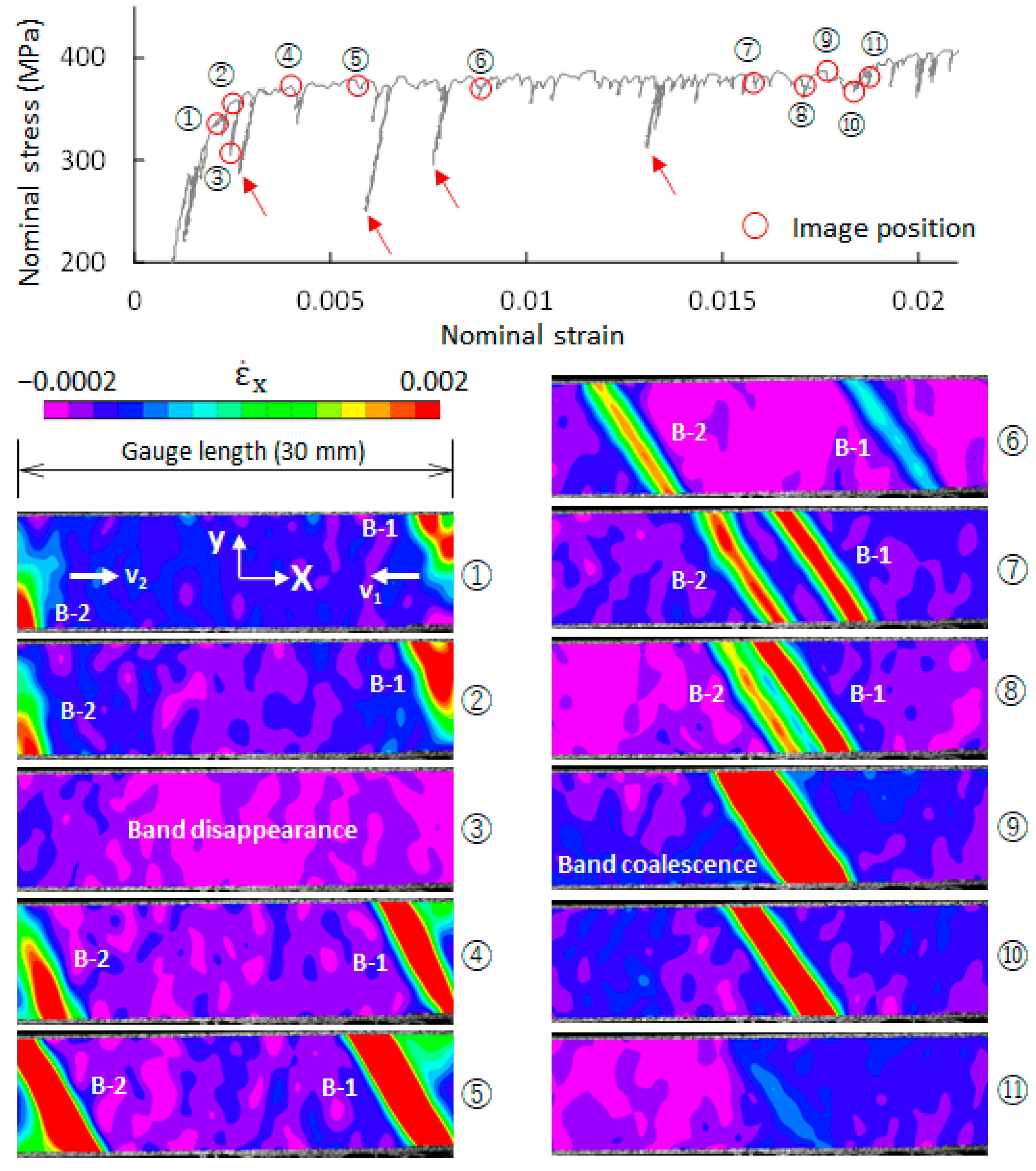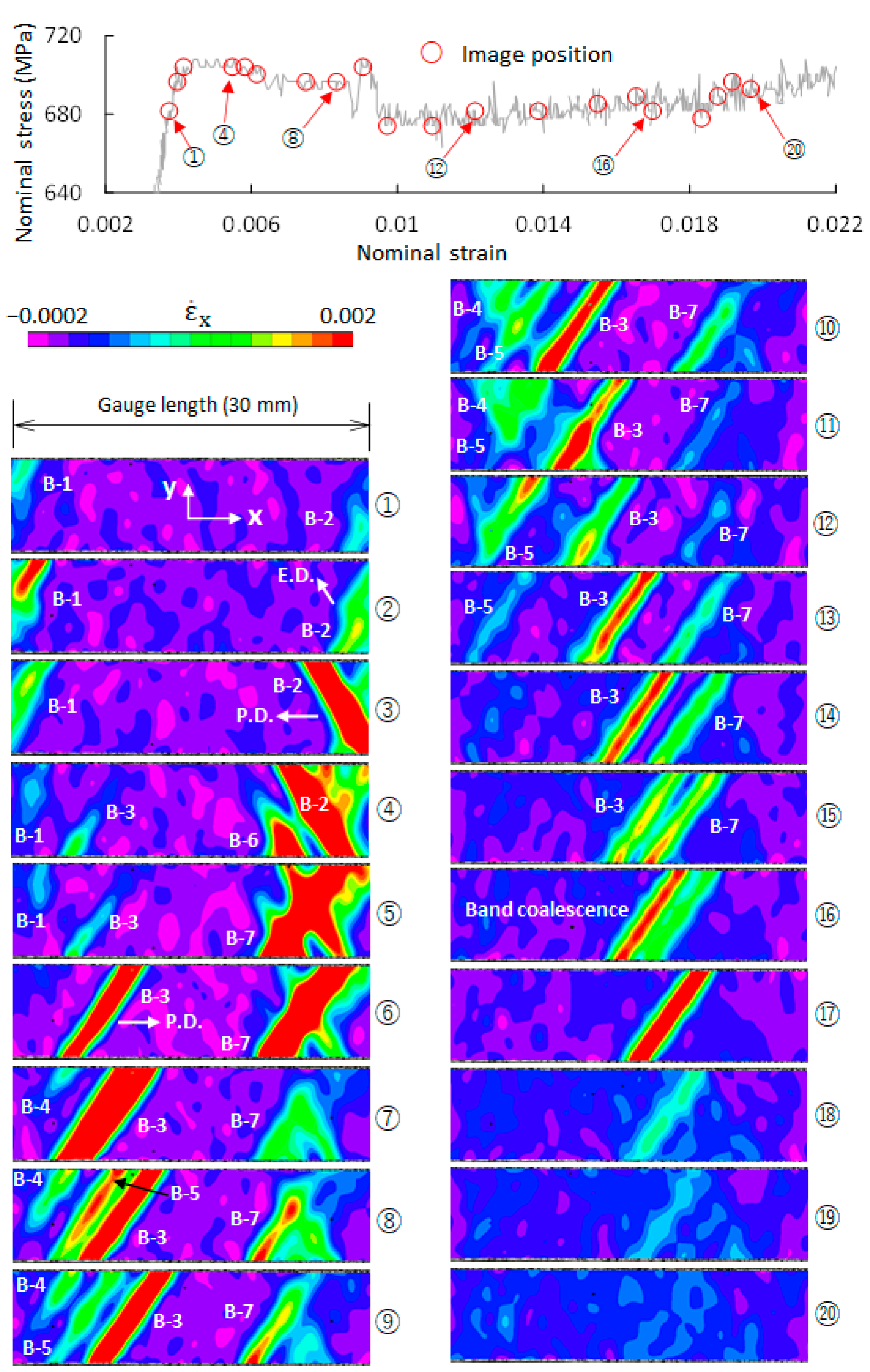Plastic Instability in Medium-Carbon Tempered Martensite Steel
Abstract
1. Introduction
2. Experimental Methods
- (1)
- Tempered martensite:Tempered martensite is the microstructure in focus for the present study. The as-received plates were heated at 850 °C for 5 min, and then were water quenched to produce martensite. The water-quenched plates were heated in a furnace (600 °C) for 20 min, followed by furnace cooling to room temperature. The tempered martensite steel plates were denoted as QT steel, which is composed of fully tempered martensite.
- (2)
- Ferrite:The Lüders phenomenon in ferrite was well investigated in the literature [2,4,5]. We selected ferritic steel as a reference for comparing the characteristic of plastic instability between the tempered martensite steel and ferritic steel. The as-received steel plates were heated at 850 °C for 5 min, and then the furnace cooled to room temperature. At 850 °C, the microstructure of the as-received steel transformed into austenite. The austenite transformed into ferrite and pearlite during furnace cooling, and the volume fraction of the ferrite and pearlite was 95.4% and 4.6%, respectively. The obtained plates were denoted as F steel.
3. Results and Discussion
3.1. Macroscopic Stress–Strain Curves
3.2. Plastic Instability
4. Conclusions
- (1)
- In the elastic-to-plastic transition region, there is no clear yield plateau on the stress–strain curve of medium-carbon tempered martensite steel;
- (2)
- The Lüders deformation phenomenon is present, but the Portevin-Le Châtelier phenomenon is not found;
- (3)
- The elastic and plastic regions are simultaneously present in the Lüders deformation process. The local strain in the elastic region is close to the elastic limit. The variation in strain within a Lüders band is significant, monotonously increasing from an elastic strain to a large plastic strain that is close to the Lüders strain;
- (4)
- The local strain distribution in tempered martensite steel during the Lüders deformation process is more complicated than that in ferrite steel.
Author Contributions
Funding
Institutional Review Board Statement
Informed Consent Statement
Data Availability Statement
Acknowledgments
Conflicts of Interest
References
- Piobert, A. Expériences sur la pénétration des projectiles dans le fer forgé. Mémoire L’artillerie 1842, 5, 502. [Google Scholar]
- Lüders, W. Ueber die aeuerung der elasticität an stahlartigen eisenstäben und stahlstäben, und über eine beim biegen solcher stäbe beobachtete molecularbewegung. Dingler Polytech. J. 1860, 155, 18–22. [Google Scholar]
- Portevin, A.; le Châtelier, F. Sur un phénomène observé lors de l′essai de traction d′alliages en cours de transformation. Comptes Rendus Ácadémie Sci. Paris 1923, 176, 507. [Google Scholar]
- Qiu, H.; Inoue, T.; Ueji, R. Experimental measurement of the variables of Lüders deformation in hot-rolled steel via digital image correlation. Mater. Sci. Eng. A 2020, 790, 139756. [Google Scholar] [CrossRef]
- Qiu, H.; Inoue, T.; Ueji, R. In-Situ observation of Lüders band formation in hot-rolled steel via digital image correlation. Metals 2020, 10, 530. [Google Scholar] [CrossRef]
- Kozłowska, A.; Grzegorczyk, B.; Morawiec, M.; Grajcar, A. Explanation of the PLC effect in advanced high-strength medium-Mn steels. Materials 2019, 12, 4175. [Google Scholar] [CrossRef]
- Renard, K.; Ryelandt, S.; Jacques, P.J. Characterisation of the Portevin-Le Châtelier effect affecting an austenitic TWIP steel based on digital image correlation. Mater. Sci. Eng. A 2010, 527, 2969–2977. [Google Scholar] [CrossRef]
- Sarmah, R.; Ananthakrishna, G. Correlation between band propagation property and the nature of serrations in the Portevin–Le Chatelier effect. Acta Mater. 2015, 91, 192–201. [Google Scholar] [CrossRef]
- Cai, Y.; Zhang, Q.; Yang, S.; Fu, S.; Wang, Y. Experimental study on three-dimensional deformation field of Portevin–Le Chatelier effect using digital image correlation. Exp. Mech. 2016, 56, 1243–1255. [Google Scholar] [CrossRef]
- Penning, P. Mathematics of the Portevin-Le Châtelier effect. Acta Metall. 1972, 20, 1169–1175. [Google Scholar] [CrossRef]
- Jiang, H.F.; Zhang, Q.C.; Chen, X.D.; Chen, Z.J.; Jiang, Z.Y.; Wu, X.P.; Fan, J.H. Three types of Portevin–Le Chatelier effects: Experiment and modelling. Acta Mater. 2007, 55, 2219–2228. [Google Scholar] [CrossRef]
- Lloyd, D.J.; Morris, L.R. Lüders band deformation in a fine grained aluminium alloy. Acta Metall. 1977, 25, 857–861. [Google Scholar] [CrossRef]
- Delwiche, D.E.; Moon, D.W. Strain profile of a propagating Lüders front. Mater. Sci. Eng. 1972, 9, 347–354. [Google Scholar] [CrossRef]
- van Rooyen, G.T. Basic factors which influence the Lüders strain during discontinuous yielding. Mater. Sci. Eng. 1971, 7, 37–48. [Google Scholar] [CrossRef]
- Tsuchida, N.; Masuda, H.; Harada, Y.; Fukaura, K.; Tomota, Y.; Nagai, K. Effect of ferrite grain size on tensile deformation behavior of a ferrite-cementite low carbon steel. Mater. Sci. Eng. A 2008, 488, 446–452. [Google Scholar] [CrossRef]
- Tsuchida, N.; Tomota, Y.; Nagai, K.; Fukaura, K. A simple relationship between Lüders elongation and work-hardening rate at lower yield stress. Scr. Mater. 2006, 54, 57–60. [Google Scholar] [CrossRef]
- El-Magd, E.; Scholles, H.; Weisshaupt, H. Influence of strain rate on the stress–strain curve in the range of Lüders strain. Steel Res. 1996, 67, 495–500. [Google Scholar] [CrossRef]
- van Rooyen, G.T. The stress and strain distribution in a propagation Lüders front accompanying the yield-point phenomenon in iron. Mater. Sci. Eng. 1968, 3, 105–117. [Google Scholar] [CrossRef]
- Cai, Y.L.; Yang, S.L.; Fu, S.H.; Zhang, Q.C. The influence of specimen thickness on the Lüders effect of a 5456 Al-based alloy: Experimental observations. Metals 2016, 6, 120. [Google Scholar] [CrossRef]
- Zhang, M.H.; Li, L.F.; Ding, J.; Wu, Q.B.; Wang, Y.D.; Almer, J.; Guo, F.M.; Ren, Y. Temperature-dependent micromechanical behavior of medium-Mn transformation-induced-plasticity steel studied by in situ synchrotron X-ray diffraction. Acta Mater. 2017, 141, 294–303. [Google Scholar] [CrossRef]
- Grzegorczyk, B.; Kozłowska, A.; Morawiec, M.; Muszyński, R.; Grajcar, A. Effect of deformation temperature on the Portevin-Le Chatelier effect in medium-Mn steel. Metals 2019, 9, 2. [Google Scholar] [CrossRef]
- Lee, S.W.; Estrin, Y.; de Cooman, B.C. Effect of the strain rate on the TRIP–TWIP transition in austenitic Fe-12 pct Mn-0.6 pct C TWIP steel. Metal. Mater. Trans. A 2014, 45, 717–730. [Google Scholar] [CrossRef]
- Cottrell, A.H.; Bilby, B.A. Dislocation theory of yielding and strain ageing of iron. Phys. Soc. 1949, 62, 49–62. [Google Scholar] [CrossRef]
- Cottrell, A.H. A note on the Portevin-le Chatelier effect. Lond. Edinb. Dublin Philos. Mag. J. Sci. 1953, 44, 829–832. [Google Scholar] [CrossRef]
- Marais, A.; Mazière, M.; Forest, S.; Parrot, A.; le Delliou, P. Identification of a strain-aging model accounting for Lüders behavior in a C-Mn steel. Philos. Mag. 2012, 92, 3589–3617. [Google Scholar] [CrossRef]
- Wang, X.G.; Wang, L.; Huang, M.X. Kinematic and thermal characteristics of Lüders and Portevin-Le Chatelier bands in a medium Mn transformation-induced plasticity steel. Acta Mater. 2017, 124, 17–29. [Google Scholar] [CrossRef]
- Tsukahara, H.; Iung, T. Finite element simulation of the Piobert–Lüders behavior in an uniaxial tensile test. Mater. Sci. Eng. A 1998, 248, 304–308. [Google Scholar] [CrossRef]
- McCormick, P.G. Theory of flow localization due to dynamic strain aging. Acta Metall. 1988, 36, 3061–3067. [Google Scholar] [CrossRef]
- Hähner, P. Modelling the spatiotemporal aspects of the Portevin-Le Chatelier effect. Mater. Sci. Eng. A 1993, 164, 23–34. [Google Scholar] [CrossRef]
- Fressengeas, C.; Beaudoin, A.J.; Lebyodkin, M.; Kubin, L.P.; Estrin, Y. Dynamic strain aging: A coupled dislocation—Solute dynamic model. Mater. Sci. Eng. A 2005, 400–401, 226–230. [Google Scholar] [CrossRef]
- Onodera, R.; Nonomura, M.; Aramaki, M. Stress drop, Lüders strain and strain rate during serrated flow. J. Jpn. Inst. Met. 2000, 64, 1162–1171. [Google Scholar] [CrossRef][Green Version]
- Hahn, G.T. A model for yielding with special reference to the yield-point phenomena of iron and related BCC metals. Acta Met. 1962, 10, 727–738. [Google Scholar] [CrossRef]
- Liu, C.Q.; Peng, Q.C.; Xue, Z.L.; Deng, M.M.; Wang, S.J.; Yang, C.W. Microstructure-tensile properties relationship and austenite stability of a Nb-Mo micro-alloyed medium-Mn TRIP steel. Metals 2018, 8, 615. [Google Scholar] [CrossRef]
- Sun, B.H.; Vanderesse, N.; Fazeli, F.; Scott, C.; Chen, J.Q.; Bocher, P.; Jahazi, M.; Yue, S. Discontinuous strain-induced martensite transformation related to the Portevin-Le Chatelier effect in a medium manganese steel. Scr. Mater. 2017, 133, 9–13. [Google Scholar] [CrossRef]
- Schwab, R.; Ruff, V. On the nature of the yield point phenomenon. Acta Mater. 2013, 61, 1798–1808. [Google Scholar] [CrossRef]





Publisher’s Note: MDPI stays neutral with regard to jurisdictional claims in published maps and institutional affiliations. |
© 2021 by the authors. Licensee MDPI, Basel, Switzerland. This article is an open access article distributed under the terms and conditions of the Creative Commons Attribution (CC BY) license (https://creativecommons.org/licenses/by/4.0/).
Share and Cite
Qiu, H.; Ueji, R.; Inoue, T.; Kimura, Y. Plastic Instability in Medium-Carbon Tempered Martensite Steel. Materials 2021, 14, 4609. https://doi.org/10.3390/ma14164609
Qiu H, Ueji R, Inoue T, Kimura Y. Plastic Instability in Medium-Carbon Tempered Martensite Steel. Materials. 2021; 14(16):4609. https://doi.org/10.3390/ma14164609
Chicago/Turabian StyleQiu, Hai, Rintaro Ueji, Tadanobu Inoue, and Yuuji Kimura. 2021. "Plastic Instability in Medium-Carbon Tempered Martensite Steel" Materials 14, no. 16: 4609. https://doi.org/10.3390/ma14164609
APA StyleQiu, H., Ueji, R., Inoue, T., & Kimura, Y. (2021). Plastic Instability in Medium-Carbon Tempered Martensite Steel. Materials, 14(16), 4609. https://doi.org/10.3390/ma14164609





